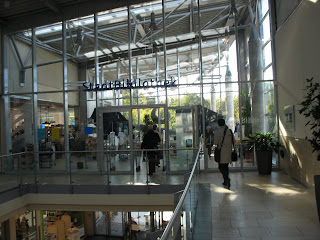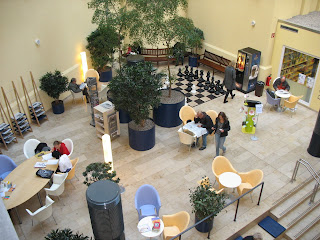
Our first stop in Bremen was at a branch library in a neighborhood with a large population of “migrational background” from Turkey, North Africa and the Near East (a very Eurocentric term). The building was shaped like a ship and filled with light. It must look like a Danish library, because Barbara Lison, director of the Stadtbibliothek Bremen, told us it was designed by an architect who likes Danish libraries.
We were introduced to Frau Martin, the branch manager, and Frau Freihalt, the children’s librarian, who had recently returned from trips sponsored by the Goethe Institute to Ramallah and the Ivory Coast, where she gave presentations on children’s librarianship.
During their presentations, the librarians explained that kids 6-12 years of age are their hauptziele Groupe (target group). Frau Martin maintains that people don’t talk in families anymore. She said this is true of German families, but especially true of immigrant families. She and Frau Freihalt try to compensate for this Sprachlosigkeit by getting children to learn, have fun and speak.
Part of the library was designed as a café, but for cultural reasons the café was not successful. The space is now occupied by a community health center with which the library partners. When the library was opened 10 years ago, there were problems with teen groups, but the library now partners with a Turkish sports club, the local Folkshochschule and other groups and neighbors have adopted the library. It has become a meeting place for all kinds of community activities.

The second library we visited was on the second floor of a shopping center in a neighborhood where many people of German (rather than migrational?) background from the former Soviet Union live. According to the director, the circulation at this library nearly doubled when it moved from the basement of a neighboring building to the shopping center a few years ago.
With the collapse of the Soviet Union, Germany admitted nearly five million descendants of Germans who in the 19th century established colonies in what became the Soviet Union. Few of these people speak modern German and the unemployment rate among them is high. This group, the elderly and children are the local library’s target groups.

For five years the central library has been housed in a former police station that was built, according to our host, in 1908 with reparations for the Franco-Prussian War. The renovation was a challenge for architects who essentially built a five-story tower in what had been the courtyard of a three-story building with high ceilings. They connected the tower to the original building with bridges at the level where the floors of both are at the same height. It is at this level that most of the collection is housed.
The Lesegarten (Reading Garden) is under a glass roof in the courtyard behind the three-story addition. It is the only area of the library where customers are allowed to eat and drink.

French and German public libraries seem more like academic libraries and to offer more academic programs than public libraries in the United States. The Interconfessional talks about literature at the Bremen library is one example. The series was started in 2006 because the library believes that dialogue about religion is “an important pre-condition for peace between religions and peace in the world.” It uses fiction as a vehicle to enable dialogue by discussing the cultural, social and religious backgrounds of a novel’s characters. The program was organized in cooperation with the Evangelishes Bildungswerk Bremen (Bureau of Professional Training of the Protestant Church in Bremen) and the Muslimische Akademie Berlin (Muslim Academy Berlin). The Catholic Church was a sponsor, our guide explained. It withdrew due to lack of funds, but is, she was sure, with them in spirit.
The library holds six talks each year – three in the spring and three in the fall. The panel always includes a Jew, a Christian, a Buddhist and a Muslim. Representatives of other religions are invited to join as appropriate. One novel is presented at each session, where a professional actor or actress reads passages. The cost of each program is €4.00. Up to 50 people attend.
The Bremen library obtains its library materials, equipment and technology through ekz bibliotheksservice GmbH. Bremen paid €10,000 for the ekz platform, which it adapted to its website, and it pays ekz an annual licensing fee of €8,000. ekz is 65% privately owned and 35% publicly owned by Bremen and other libraries. The library-owners have greater influence than their share of ownership would imply, because some actions cannot be taken without their unanimous approval. ekz’s contracts with content providers often include restrictions on use.
All six libraries I have visited in Germany have fabulous music collections. They have thousands of CDs, which you can search by period, composer, artist, group or instrument, and there are probably a few other categories I’m forgetting about. They also have shelves and shelves of sheet music, and shelves and shelves of books about music. Many of these libraries also have extensive art collections from which customers can borrow items. The loan period is usually three months.
As I mentioned before, libraries in Germany are not free. The annual cost ranges from €15 to €25 with added fees for other services, but children join the library for free, and there are discounts for seniors, the handicapped and the unemployed, and group rates for families. In Bremen, for example, card holders get two and students get four hours of free internet access each week, but if they want to get six hours of each week, they have to pay an additional €10. If they are 18 years old or older and want to borrow any of the 3,280 pieces of art the library owns, that’s another €10. And with the new self-service RFID, cqrd holders can subscribe to these services themselves when they buy or renew their library card.
Das Leben in Bremen
Nearly 65 years after Second World War ended, you are frequently reminded of it in Germany. In Bremen we were told that 85% of the city was destroyed. Whether rebuilt or spared destruction, many of the old buildings in the center of the city, like the Rathaus (city hall), are magnificent. With lots of red brick, winding streets and ornate architectural styles I’ve seen nowhere else, Bremen and Hamburg are two cities I would like to explore further.
Barbara Lison is a master of (dare I say German?) organization and efficiency. We stayed at a hotel near the Hauptbahnhof (main train station) and not far from the central library. Barbara arrived at the hotel by bicycle to escort us on a brief tour of the city center and to dinner at a restaurant where we ate typical North German food. On the following day, she arranged transportation to branch libraries and the central library in four vehicles. At each location it seemed the entire staff was involved in our visit.
As at the libraries we visited in other cities, a staff member provided simultaneous translation to English if the presentation was in German. For lunch at the central library we had our choice of potato soup or a soup made with meat and tomatoes. Both were very good. They were served with white bread like a French baguette. Dessert was a variety of cookies, or biscuits as the Germans like to say. Barbara arranged transportation to the airport toward the end of our visit for one of our group who had to return early to France. Everything happened how it was supposed to happen and when it was supposed to happen and we arrived back at the station in plenty of time to catch our train to Hamburg.
At dinner we were encouraged to try one of the herring dishes, which I did. My cold herring was served with two warm potato pancakes, cranberry sauce and whipped cream. The pancakes, cranberries and whipped cream seemed to go together well enough. It was the herring that just didn’t seem to belong.
No comments:
Post a Comment